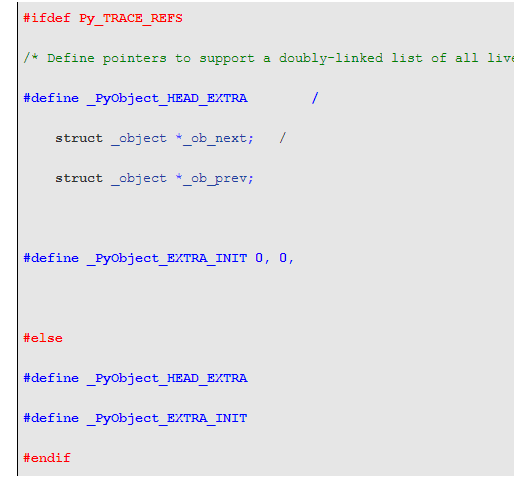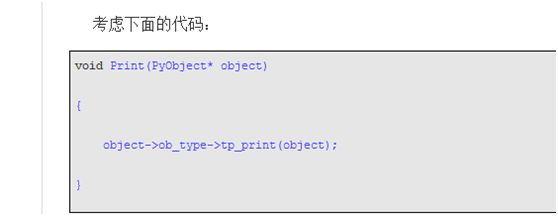Python对象初探
数据结构
PyObject_HEAD //对象公共头部
Py_ssize_t ob_refcnt; //对象引用数 PyTypeObject *ob_type; //对象类型 PyObject_VAR_HEAD //这个就是属于可变对象头部啦
PyObject_HEAD //对象头部 Py_ssize_t ob_size;//元素个数 展开了就是
PyObject_VAR_HEAD = {
Py_ssize_t ob_refcnt; //对象引用数 PyTypeObject *ob_type; //对象类型 Py_ssize_t ob_size;//元素个数 }
PyObject_HEAD_INIT(type) //不可变对象初始化
This is a macro which expands to initialization values for a new PyObject type. This macro expands to:
_PyObject_EXTRA_INIT
1, type,
//头部初始化,对象引入数初始化为1,对象类型为传入来的类型对象
PyVarObject_HEAD_INIT(type, size)¶//可变对象初始化
This is a macro which expands to initialization values for a new PyVarObject type, including the ob_size field. This macro expands to:
_PyObject_EXTRA_INIT
1, type, size,
//头部初始化,对象引入数初始化为1,对象类型为传入来的类型对象,大小为传进来的大小
而上面都有一个_PyObject_EXTRA_INIT 这个是因为系统定义了 Py_TRACE_REFS 所有要初始化 next和prev这两个指针 
/* PyObject_HEAD defines the initial segment of every PyObject. */ #define PyObject_HEAD / _PyObject_HEAD_EXTRA / int ob_refcnt; / struct _typeobject *ob_type;
#define PyObject_VAR_HEAD / PyObject_HEAD / int ob_size; /* Number of items in variable part */
不变对象定义
typedef struct _object {
PyObject_HEAD
} PyObject;
可变对象定义
typedef struct { PyObject_VAR_HEAD } PyVarObject; 看书一定要仔细啊
类型对象的结构
[object.h]
typedef struct _typeobject {
PyObject_VAR_HEAD
char *tp_name; /* For printing, in format "<module>.<name>" */
int tp_basicsize, tp_itemsize; /* For allocation */
/* Methods to implement standard operations */
destructor tp_dealloc;
printfunc tp_print;
……
/* More standard operations (here for binary compatibility) */
hashfunc tp_hash;
ternaryfunc tp_call;
……
} PyTypeObject;
在_typeobject的定义中包含了许多的信息,主要可以分为四类:
1.类型名,tp_name,主要是Python内部以及调试的时候使用;
2.创建该类型对象是分配内存空间的大小的信息,即tp_basicsize和tp_itemsize;
3.与该类型对象相关联的操作信息,比如hashfunc,tp_hash就指明对于该类型的对象,如何生成其hash值。在Object.h中可以看到,hashfunc实际上是一个函数指针:typedef long (*hashfunc)(PyObject *); 在_typeobject中,包含了大量的函数指针,这些函数指针将用来指定某个类型的操作信息。这些操作主要分为标准操作(dealloc, print, compare),标准操作族(numbers, sequences, mappings),以及其他操作(hash, buffer, call…)。
接下来我们看看整形是如何初始化的
[intobject.c]
PyTypeObject PyInt_Type = {
PyObject_HEAD_INIT(&PyType_Type)
0,
"int",
sizeof(PyIntObject),
……
};
PyType_Type这个又是什么东西啊
PyObject_HEAD_INIT 这个宏定义如下这样的, 
PyType_Type 这个的数据结构是这样的,其实我觉得它是PyTypeObject的一个实例
[typeobject.c]
PyTypeObject PyType_Type = {
PyObject_HEAD_INIT(&PyType_Type)
/*
上面宏展开就是
1 //引用计数
&PyType_Type
*/
0, /* ob_size 元素个数*/
"type", /* tp_name */
sizeof(PyHeapTypeObject), /* tp_basicsize */
sizeof(PyMemberDef), /* tp_itemsize */
……
PyObject_GC_Del, /* tp_free */
(inquiry)type_is_gc, /* tp_is_gc */
};
还是看源码好过
[intobject.h] typedef struct { PyObject_HEAD /* 这里宏展开就是 Py_ssize_t ob_refcnt; //对象引用数 PyTypeObject *ob_type; //对象类型 */ long ob_ival; } PyIntObject;
PyTypeObject PyInt_Type = { PyObject_HEAD_INIT(&PyType_Type) /* 这里宏展开就是 1 //引用计数 &PyType_Type //类型对象 */
0, //元素个数 "int", sizeof(PyIntObject), 0, (destructor)int_dealloc, /* tp_dealloc */ (printfunc)int_print, /* tp_print */ 0, /* tp_getattr */ 0, /* tp_setattr */ (cmpfunc)int_compare, /* tp_compare */ (reprfunc)int_repr, /* tp_repr */ &int_as_number, /* tp_as_number */ 0, /* tp_as_sequence */ 0, /* tp_as_mapping */ (hashfunc)int_hash, /* tp_hash */ 0, /* tp_call */ (reprfunc)int_repr, /* tp_str */ PyObject_GenericGetAttr, /* tp_getattro */ 0, /* tp_setattro */ 0, /* tp_as_buffer */ Py_TPFLAGS_DEFAULT | Py_TPFLAGS_CHECKTYPES | Py_TPFLAGS_BASETYPE, /* tp_flags */ int_doc, /* tp_doc */ 0, /* tp_traverse */ 0, /* tp_clear */ 0, /* tp_richcompare */ 0, /* tp_weaklistoffset */ 0, /* tp_iter */ 0, /* tp_iternext */ int_methods, /* tp_methods */ 0, /* tp_members */ 0, /* tp_getset */ 0, /* tp_base */ 0, /* tp_dict */ 0, /* tp_descr_get */ 0, /* tp_descr_set */ 0, /* tp_dictoffset */ 0, /* tp_init */ 0, /* tp_alloc */ int_new, /* tp_new */ (freefunc)int_free, /* tp_free */ }; 到这里我们还没发现PyType_Type 这个东西有什么用

打印的方法 根本就没有用到那个属性
这个图还不错
